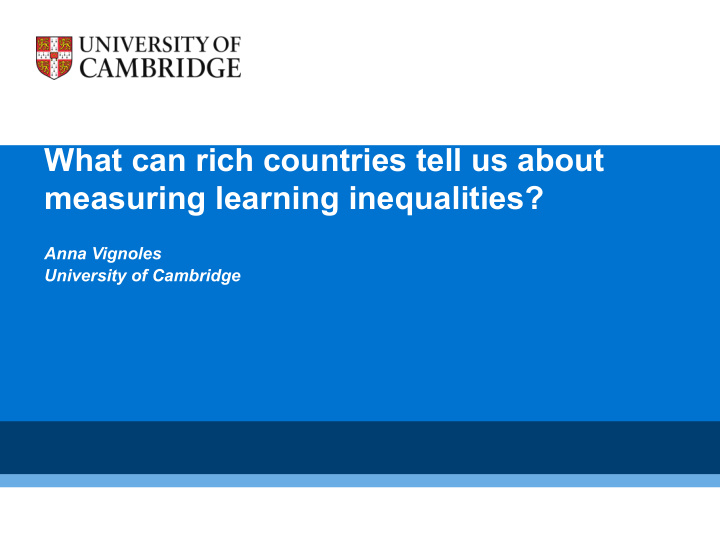



What can rich countries tell us about measuring learning inequalities? Anna Vignoles University of Cambridge
• How are inequalities in learning measured in developed countries ? • Is there scope for measures to be aligned across contexts?
Inequalities between groups Gender Ethnicity Socio-economic background Disability Sexuality
How are inequalities monitored? Census data International data Rich survey data, tracking individual e.g the UK birth PISA, TIMSS, children through cohorts PIRLS etc the system
What measures of learning are used in the UK? • National tests of reading, writing and Achievement maths at ages 7 & 11, linked to the curriculum tests • National tests of range of subjects at 16, GCSEs Measures of non-cognitive • Exclusions development
What measures of learning are used in the UK? Measures of • Participation in HE longer run • Participation in elite HE • Vocational qualifications outcomes • Employment • Some countries have developed their own tests modelled on PISA • UK has linked PISA data to administrative data PISA • Assess grade inflation claims, despite misalignment of measures • Common metric would help here
What measures of SES are used for system monitoring? • Measure of welfare receipt • Closely correlated with single parenthood Free school (50% of those eligible are in single parent meal eligibility households) and workless or low income households Neighbourhood • Neighbourhood HE participation rate (HEFCE’s POLAR2) data (from • IDACI (Income Deprivation Affecting population Children Index) Census) • IMD (Index of Multiple Deprivation)
In the UK the system is very well monitored. • For example you can do this … .. • Linked individual-level administrative data – School and HE records • State and private school students • Combine FSM and neighbourhood measures – In Year 11 in 2001-02 or 2002-03
Male ¡HE ¡par*cipa*on, ¡ ¡ ¡ ¡ ¡ ¡ ¡ ¡ ¡ ¡ ¡ ¡ ¡ ¡ ¡ ¡ ¡ ¡ ¡ ¡ ¡ ¡ ¡ ¡ ¡ by ¡depriva*on ¡quin*le ¡ State school pupils State and private school pupils ¡ ¡ ¡ 0 10 20 30 40 0 10 20 30 40 % participating in HE at 19/20 % participating in HE at 19/20 Least deprived quintile 2nd quintile 3rd quintile 4th quintile Most deprived quintile
• When do inequalities in learning emerge and hence at what points in the education life-cycle should we track learning ? • We know … – Socio-economic gaps in cognitive skill emerge very early indeed – Strong intergenerational component to education
The situation in the UK Goodman & Gregg (2010)
SES gaps are evident from age 7 onwards in census data 100 80 60 40 20 0 Sample Always Not always Most Least Non-select Selective Private average FSM FSM deprived deprived state state second. second. second. Studying for a degree at an elite university 3+ A-B in any subjects at A-level 5+ A*-C in EBacc subjects at GCSE Level 5+ at KS2 in English and maths Level 3+ at KS1 in reading and maths
• What are the possible unintended consequences of measuring learning and how can some of these can be averted ?
What has the UK learned? If measures are used in Policy response in the a strong accountability UK has been to system they will be redesign metrics to manipulated avoid gaming GCSE scores Value Added, CVA, 5A*-C GCSE, Progress 8 ……
What has the UK learned? Value added Teacher reports measures are cannot be used for needed to measure accountability quality of schools but not to Appropriate monitor for formative progress assessment 15
What has the UK learned? International surveys as distinct from national census data can help measure real progress in achievement Some caution using national high stakes tests to measure progress Dangers of excessive testing
References • Chowdry, H., Crawford, C., Dearden, L., Goodman, A., & Vignoles, A. (2013). Widening participation in higher education: Analysis using linked administrative data. Journal of the Royal Statistical Society: Series A (Statistics in Society), 176, 431–457. • Gregg, P. and Goodman, A. (2011) Poorer children’s educational attainment: how important are attitudes and behaviour? , Joseph Rowntree Foundation report. • See reports for Commission for Social Mobility http://dera.ioe.ac.uk/18589/ and http://www.ifs.org.uk/publications/7256 • Jerrim, J. and Vignoles, A. (2013), Social mobility, regression to the mean and the cognitive development of high ability children from disadvantaged homes. Journal of the Royal Statistical Society: Series A (Statistics in Society), 176: 887–906. doi: 10.1111/j.1467-985X. 2012.01072.x
18
Recommend
More recommend